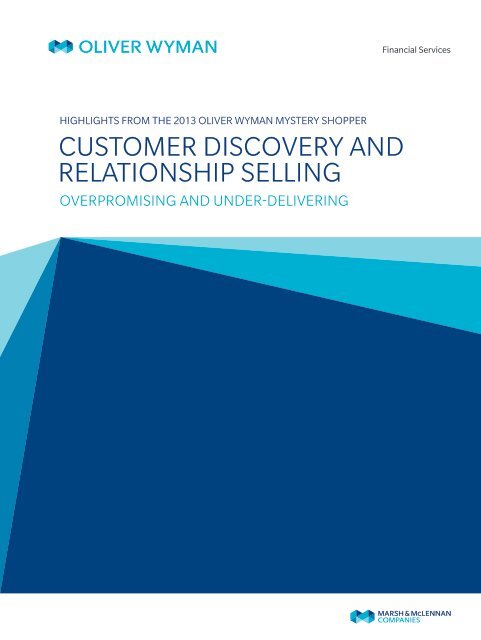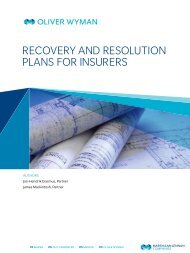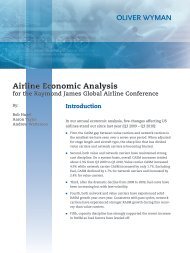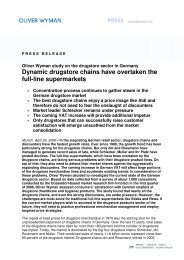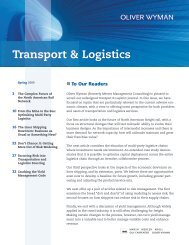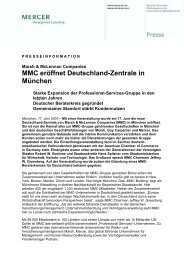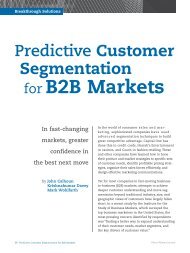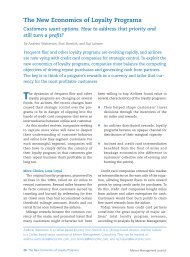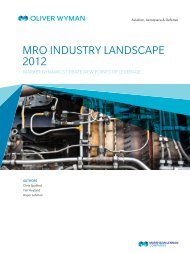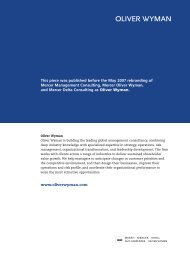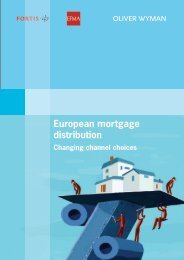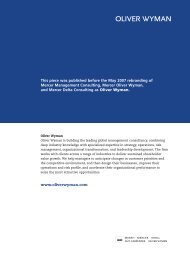Download the Report - Oliver Wyman
Download the Report - Oliver Wyman
Download the Report - Oliver Wyman
You also want an ePaper? Increase the reach of your titles
YUMPU automatically turns print PDFs into web optimized ePapers that Google loves.
Financial Services<br />
HIGHLIGHTS FROM THE 2013 OLIVER WYMAN MYSTERY SHOPPER<br />
CUSTOMER DISCOVERY AND<br />
RELATIONSHIP SELLING<br />
OVERPROMISING AND UNDER-DELIVERING
SUMMARY<br />
Almost all large banks have publicly stated <strong>the</strong>ir intent to deepen customer relationships,<br />
i.e. get <strong>the</strong>m to use more products from <strong>the</strong> bank. However, few of <strong>the</strong>se large banks have<br />
instituted sales practices that translate intent into effective action. This is <strong>the</strong> key finding of<br />
an <strong>Oliver</strong> <strong>Wyman</strong> mystery shop of 13 large banks. We set out to understand cross-selling<br />
practices associated with opening checking accounts in a branch and applying for a<br />
mortgage. In both areas, <strong>the</strong>re are missed deepening opportunities:<br />
••<br />
Checking accounts – While almost all <strong>the</strong> banks tried to cross-sell savings accounts and<br />
credit cards during checking account origination, few tried to understand o<strong>the</strong>r financial<br />
needs, particularly investments and retirement needs<br />
••<br />
Mortgage – Only 5 of <strong>the</strong> 13 banks asked about o<strong>the</strong>r products during a mortgage<br />
application conversation<br />
We believe that banks are missing golden opportunities to leverage <strong>the</strong>se account opening<br />
events, where customers are fully engaged in discussing <strong>the</strong>ir financial relationships. Customer<br />
needs discovery at <strong>the</strong>se times can strongly influence cross-sell later – but many banks are<br />
missing out on this. They’re promising all <strong>the</strong> right things but typically failing to deliver.<br />
THE (OVER) PROMISE<br />
Large banks have publicly stated <strong>the</strong>ir intent<br />
to deepen customer relationships, especially<br />
those where <strong>the</strong>y have <strong>the</strong> customer’s primary<br />
checking account. Theoretically this adds<br />
revenue and profits at lower all-in origination<br />
costs. Our analysis also shows that customers<br />
with deeper relationships tend to attrite less,<br />
even after controlling for confounding factors<br />
such as income and investable assets.<br />
Yet, <strong>the</strong> average consumer today has less<br />
than one additional banking product with<br />
<strong>the</strong>ir primary checking bank. This is a clear<br />
lost opportunity when 55% of consumers<br />
agree that <strong>the</strong>re would be benefits to<br />
having multiple products with <strong>the</strong> same<br />
bank 1 . So both sides want to consolidate<br />
<strong>the</strong> relationship – consumers appreciate<br />
<strong>the</strong> ease and transparency of having <strong>the</strong>ir<br />
accounts in one place, and banks want more<br />
profitable and stickier relationships. So why<br />
doesn’t it happen more?<br />
Exhibit 1: ANNUAL PRIMARY DDA<br />
ATTRITION RATE BY NUMBER OF<br />
PRODUCTS AT PRIMARY BANK<br />
% OF RESPONDENTS WITH $50–150 K ANNUAL INCOME<br />
AND $100–500 K IN INVESTABLE ASSETS<br />
16<br />
1<br />
8<br />
2<br />
3<br />
NUMBER OF PRODUCTS<br />
9<br />
4<br />
4 or more<br />
Source: <strong>Oliver</strong> <strong>Wyman</strong> 2012 Survey of Consumer Finances<br />
1 Source: <strong>Oliver</strong> <strong>Wyman</strong> 2012 Survey of Consumer Finances (n=5,000)<br />
3
THE (UNDER) DELIVERY<br />
Our research shows that most banks are not leveraging <strong>the</strong>ir key opportunity to deepen<br />
relationships. We mystery shopped 13 large banks 2 to understand <strong>the</strong>ir processes for<br />
opening a checking account in a branch. This is likely <strong>the</strong> best captive audience a banker<br />
can ever have – <strong>the</strong> customer is engaged, has taken out time from her busy schedule and<br />
has already committed to starting a relationship. This should be where banks translate<br />
“deepening intent” into action.<br />
••<br />
The good news: every bank tried to determine if <strong>the</strong> customer needed o<strong>the</strong>r banking<br />
products and almost every bank asked about savings accounts and credit cards<br />
••<br />
The bad news: only five banks asked about o<strong>the</strong>r needs and only two banks had <strong>the</strong><br />
customer undergo a holistic assessment to understand current and future financial<br />
needs (see Exhibit 2)<br />
At a certain level, <strong>the</strong> data in Exhibit 2 is intuitive. Savings accounts belong to <strong>the</strong> same<br />
deposits product family as checking, a customer’s open-to-buy on credit cards is usually higher<br />
than any o<strong>the</strong>r retail banking product and both of <strong>the</strong>se products are also very profitable.<br />
Exhibit 2: ADDITIONAL PRODUCTS THAT BANKS ENQUIRED ABOUT*<br />
% OF BANKS INQUIRING ABOUT NEED<br />
92 92<br />
31<br />
23 23<br />
15<br />
8<br />
Savings<br />
account<br />
Credit<br />
card<br />
Investments<br />
ID <strong>the</strong>ft<br />
protection<br />
Retirementrelated<br />
Insurance<br />
Home<br />
financing<br />
Auto<br />
loans<br />
* When a mystery shopper was opening a checking account<br />
Source: <strong>Oliver</strong> <strong>Wyman</strong> 2013 Mystery Shopper<br />
2 Including Bank of America, BB&T, Capital One, Chase, Citibank, Fifth Third, HSBC, PNC Bank, SunTrust, TD Bank, US Bank and Wells<br />
Fargo. Branches mystery shopped were located in New York, Washington DC, Atlanta, Boston, Cincinnati and San Francisco<br />
Copyright © 2013 <strong>Oliver</strong> <strong>Wyman</strong>
However, by not discussing investments or retirement-related needs, banks are missing out<br />
on a huge opportunity. 22% of US households have more than $150 K in investable assets 3<br />
and would be very profitable investment customers, so at <strong>the</strong> very least, banks should try and<br />
understand if this need exists. We also believe that banks are missing out on a big opportunity<br />
to capture IRA rollovers as an entry point to a broader investments relationship 4 . Therefore,<br />
understanding how customers are thinking about retirement is particularly relevant.<br />
The results are even worse for <strong>the</strong> mortgage application process – only five banks even asked<br />
about o<strong>the</strong>r products and mostly only checking accounts.<br />
Yet some banks do see an opportunity to leverage <strong>the</strong> mortgage application process to convert<br />
mono-product customers into deeper relationships. These banks make mortgage pricing<br />
contingent on <strong>the</strong> ownership of checking accounts. The typical offer was a rate discount on<br />
<strong>the</strong> mortgage (off <strong>the</strong> published rate) if monthly payments were automatically deducted from<br />
a linked checking account. A few banks also linked mortgage pricing to having an investment<br />
relationship with <strong>the</strong> bank. Since customers are far more price-sensitive on mortgages than<br />
any o<strong>the</strong>r banking product, it makes sense for banks to leverage it via this mechanism (subject<br />
to compliance with anti-tying rules).<br />
Exhibit 3: RELATIONSHIP SELLING IN MORTGAGE<br />
Q. WHAT OTHER PRODUCTS DID THE BANK TRY TO<br />
SELL YOU?<br />
% OF BANKS OFFERING OTHER PRODUCTS<br />
Q. DID THE BANK MAKE MORTGAGE PRICING<br />
CONTINGENT ON OTHER PRODUCTS?<br />
% OF BANKS TRYING TO SELL CHECKING<br />
WITH MORTGAGE<br />
No<br />
20%<br />
Yes<br />
80%<br />
38<br />
8 8<br />
Checking Investments Credit card<br />
Source: <strong>Oliver</strong> <strong>Wyman</strong> 2013 Mystery Shopper<br />
3 Source: US Census Bureau, Survey of Income and Program Participation 2011 update and <strong>Oliver</strong> <strong>Wyman</strong> analysis<br />
4 See our white paper:“Retail Banks & <strong>the</strong> IRA Rollover Opportunity: Down But Not Out”<br />
5
HOW BANKS CAN IMPROVE<br />
We see three main levers to deepen customer relationships:<br />
SALES PROCESS AND INCENTIVES REDESIGN<br />
Our experience suggests that banks need to rethink <strong>the</strong>ir sales processes, whe<strong>the</strong>r in<br />
<strong>the</strong> branch or o<strong>the</strong>r channels, to take better advantage of <strong>the</strong> origination interaction.<br />
Opening a checking account is often a consumer’s first contact with a bank and offers<br />
an excellent opportunity to introduce a wider suite of products. While many banks have<br />
focused on reducing <strong>the</strong> amount of time it takes to open an account 5 , <strong>the</strong> leading banks<br />
use this opportunity to identify <strong>the</strong> full breadth of financial needs, resulting in a longer<br />
overall process. One commonly-heard objection is that customers will be put off by<br />
incessant questioning, but that is largely a function of training. If branch salespeople act<br />
as if <strong>the</strong>y’re reading off a script, <strong>the</strong>y will come across as too pushy. The best banks have a<br />
conversational sales process that feels like a banker is really trying to understand how she<br />
can be more helpful to her customer; whereas at underperforming banks this feels more<br />
like filling out a form.<br />
Incentives, particularly for referrals, are also critical to deepening <strong>the</strong> customer relationship<br />
beyond deposit products. For example, few bankers are equipped to talk about investments,<br />
so <strong>the</strong>y should be incented to bring in product specialists once a need has been identified.<br />
BUILDING A DISTINCT “CONSOLIDATION EXPERIENCE”<br />
For customers who are seeking multiple relationships, banks can create a separate process<br />
that focuses on taking out <strong>the</strong> associated friction. For example, customers who decide to<br />
open a checking account while taking out a mortgage can be routed to a separate queue for<br />
processing. This should not be done on a blanket basis for all such customers, only where <strong>the</strong><br />
incremental value justifies <strong>the</strong> additional cost – hence should be based on mortgage amount<br />
and expected checking balances.<br />
5 Only 24% of customers are hassled by <strong>the</strong> time it takes to open a checking account in a branch according to <strong>the</strong> 2013 <strong>Oliver</strong> <strong>Wyman</strong><br />
Customer Experience Survey<br />
Copyright © 2013 <strong>Oliver</strong> <strong>Wyman</strong>
RELATIONSHIP PRICING<br />
Banks need to get smarter at using relationship pricing, both from a structural and an<br />
articulation perspective. Mortgage rate discounts for acquiring checking relationships<br />
are effective, but only if priced correctly and in <strong>the</strong> appropriate situation. In our mystery<br />
shopping, one bank communicated that <strong>the</strong>ir best price was contingent on <strong>the</strong> applicant<br />
setting up automatic monthly payments from a linked checking account, but didn’t explicitly<br />
offer a discount. Given <strong>the</strong> economics of a mortgage, even a small discount may be valuedestroying<br />
and should only be used where <strong>the</strong> benefit exchange is suitable, for example in<br />
a jumbo mortgage being taken by a high-net-worth client. Relationship pricing should also<br />
focus on reinforcing desired behaviors on an ongoing basis, e.g. fee waivers on checking<br />
accounts tied to credit card usage. One-off discounts are less effective in delivering a longterm<br />
relationship, since <strong>the</strong>y reinforce a transactional element.<br />
Our research shows that <strong>the</strong>re is significant deepening opportunity associated with a<br />
customer’s first interaction with <strong>the</strong> bank. Yet most large banks have a long way to go<br />
before <strong>the</strong>y can capture this opportunity. The old adage “well-begun is half done” may<br />
never have been truer.<br />
7
<strong>Oliver</strong> <strong>Wyman</strong> is a global leader in management consulting that combines deep industry knowledge with specialized expertise in<br />
strategy, operations, risk management, and organization transformation.<br />
For more information please contact <strong>the</strong> marketing department by email at info-FS@oliverwyman.com or by phone at<br />
one of <strong>the</strong> following locations:<br />
AMERICAS<br />
+1 212 541 8100<br />
EMEA<br />
+44 20 7333 8333<br />
ASIA PACIFIC<br />
+65 6510 9700<br />
ABOUT THE AUTHORS<br />
Inderpreet Batra is a Partner in <strong>Oliver</strong> <strong>Wyman</strong>’s Financial Services Practice.<br />
Alina Lantsberg is a Manager in <strong>Oliver</strong> <strong>Wyman</strong>’s Financial Services Practice.<br />
www.oliverwyman.com<br />
Copyright © 2013 <strong>Oliver</strong> <strong>Wyman</strong><br />
All rights reserved. This report may not be reproduced or redistributed, in whole or in part, without <strong>the</strong> written permission of <strong>Oliver</strong> <strong>Wyman</strong> and<br />
<strong>Oliver</strong> <strong>Wyman</strong> accepts no liability whatsoever for <strong>the</strong> actions of third parties in this respect.<br />
The information and opinions in this report were prepared by <strong>Oliver</strong> <strong>Wyman</strong>. This report is not investment advice and should not be relied on for such<br />
advice or as a substitute for consultation with professional accountants, tax, legal or financial advisors. <strong>Oliver</strong> <strong>Wyman</strong> has made every effort to use<br />
reliable, up-to-date and comprehensive information and analysis, but all information is provided without warranty of any kind, express or implied.<br />
<strong>Oliver</strong> <strong>Wyman</strong> disclaims any responsibility to update <strong>the</strong> information or conclusions in this report. <strong>Oliver</strong> <strong>Wyman</strong> accepts no liability for any loss<br />
arising from any action taken or refrained from as a result of information contained in this report or any reports or sources of information referred<br />
to herein, or for any consequential, special or similar damages even if advised of <strong>the</strong> possibility of such damages. The report is not an offer to buy<br />
or sell securities or a solicitation of an offer to buy or sell securities. This report may not be sold without <strong>the</strong> written consent of <strong>Oliver</strong> <strong>Wyman</strong>.


